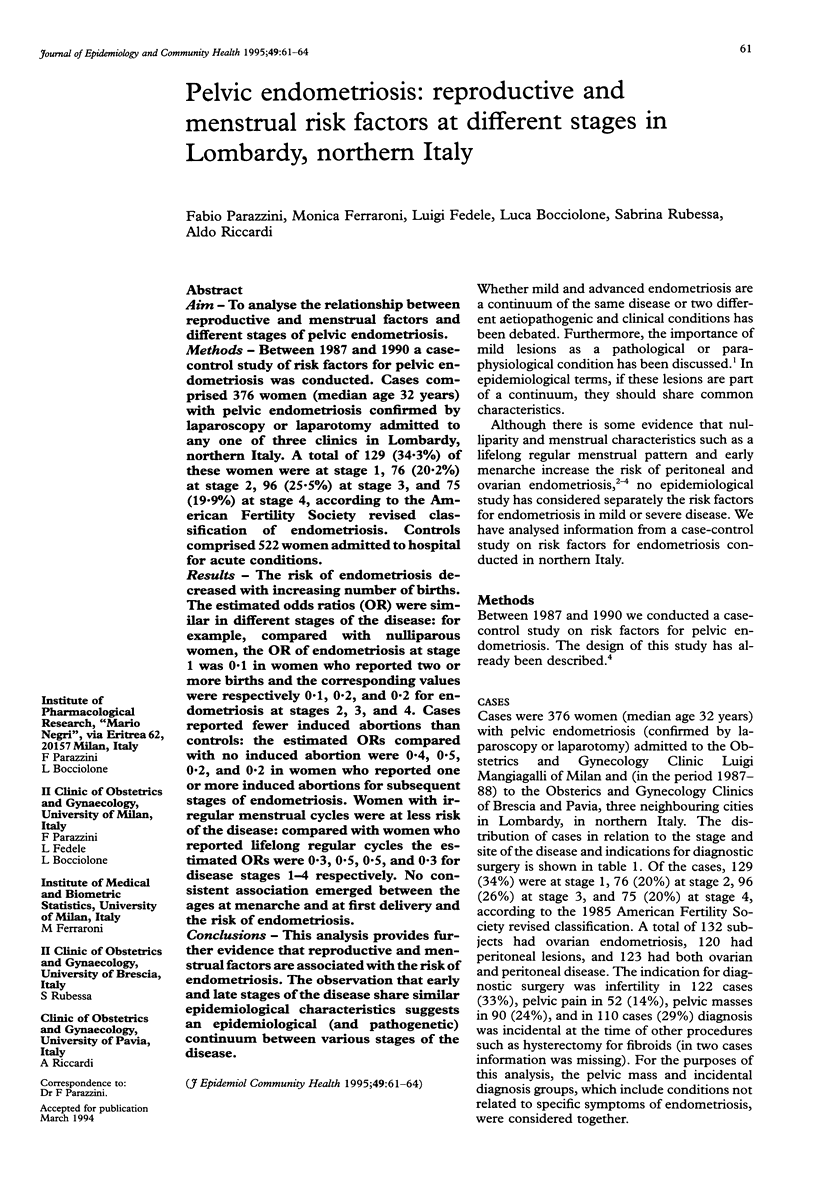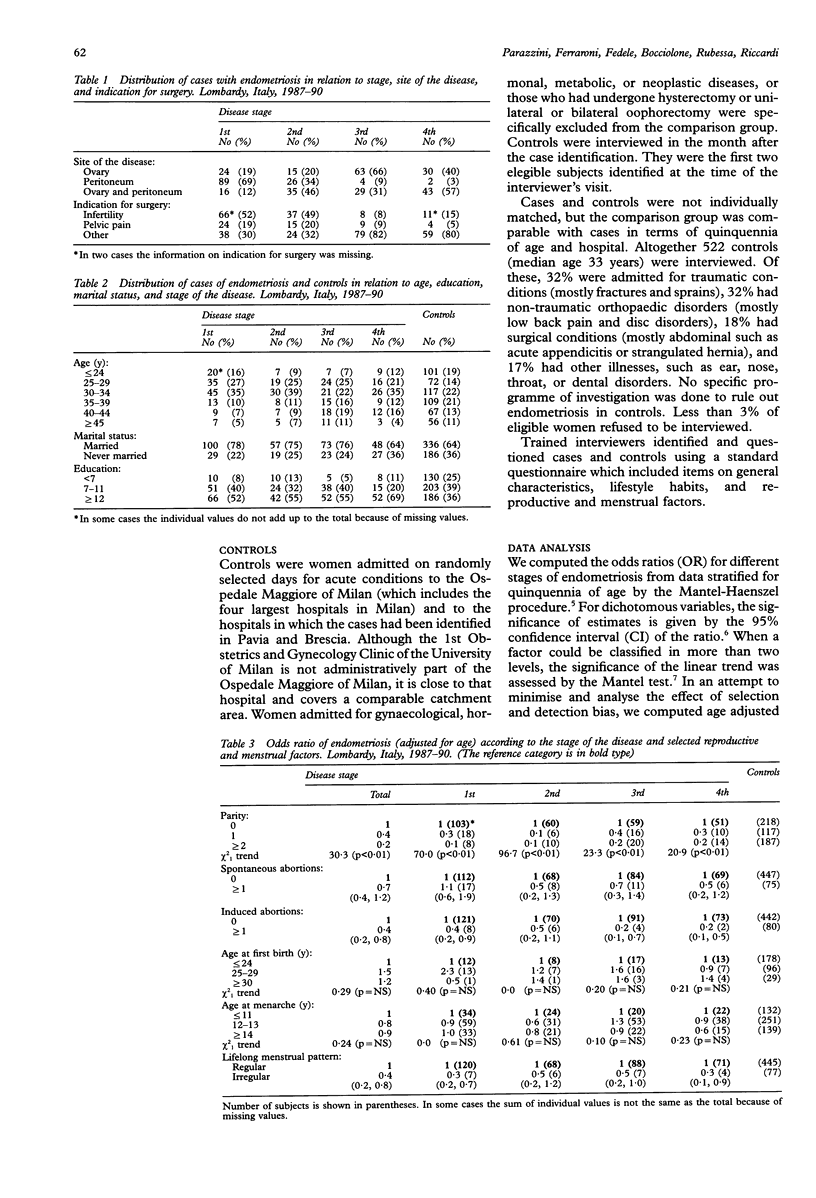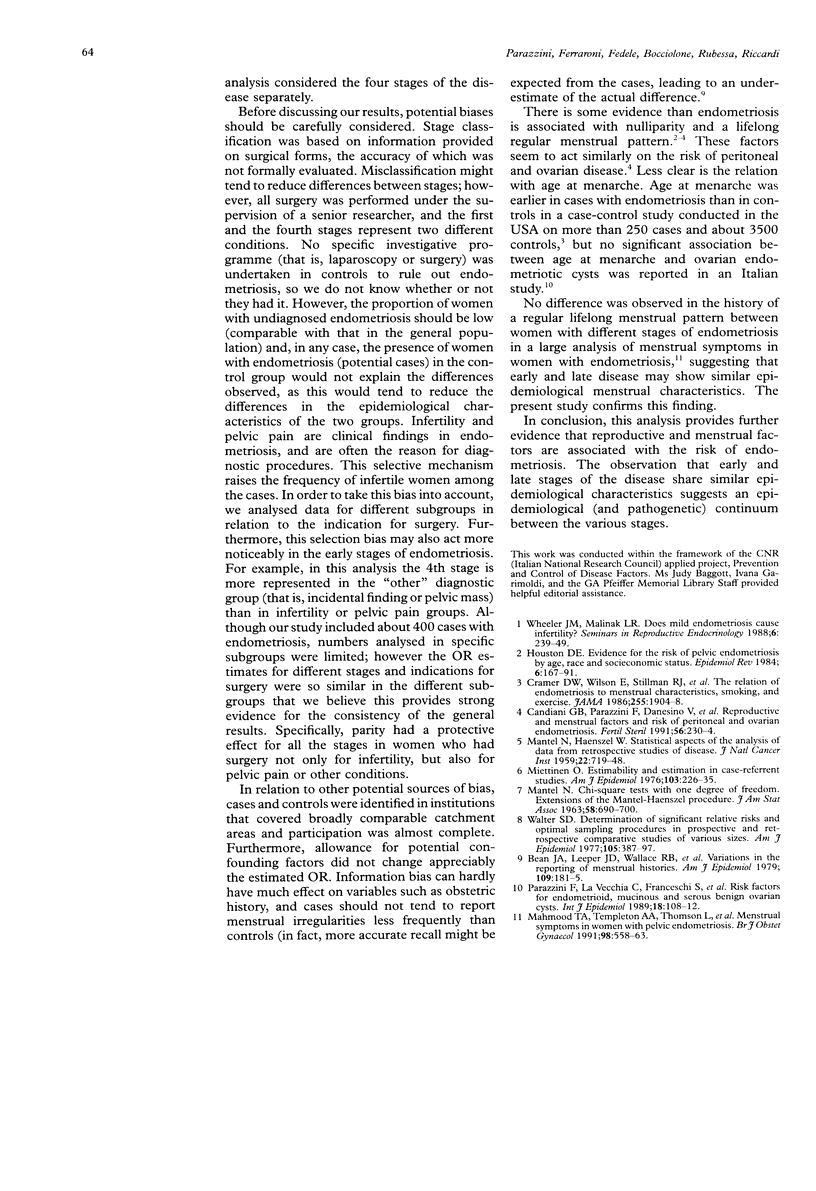Abstract
AIM--To analyse the relationship between reproductive and menstrual factors and different stages of pelvic endometriosis. METHODS--Between 1987 and 1990 a case-control study of risk factors for pelvic endometriosis was conducted. Cases comprised 376 women (median age 32 years) with pelvic endometriosis confirmed by laparoscopy or laparotomy admitted to any one of three clinics in Lombardy, northern Italy. A total of 129 (34.3%) of these women were at stage 1, 76 (20.2%) at stage 2, 96 (25.5%) at stage 3, and 75 (19.9%) at stage 4, according to the American Fertility Society revised classification of endometriosis. Controls comprised 522 women admitted to hospital for acute conditions. RESULTS--The risk of endometriosis decreased with increasing number of births. The estimated odds ratios (OR) were similar in different stages of the disease: for example, compared with nulliparous women, the OR of endometriosis at stage 1 was 0.1 in women who reported two or more births and the corresponding values were respectively 0.1, 0.2, and 0.2 for endometriosis at stages 2, 3, and 4. Cases reported fewer induced abortions than controls: the estimated ORs compared with no induced abortion were 0.4, 0.5, 0.2, and 0.2 in women who reported one or more induced abortions for subsequent stages of endometriosis. Women with irregular menstrual cycles were at less risk of the disease: compared with women who reported lifelong regular cycles the estimated ORs were 0.3, 0.5, 0.5, and 0.3 for disease stages 1-4 respectively. No consistent association emerged between the ages at menarche and at first delivery and the risk of endometriosis. CONCLUSIONS--This analysis provides further evidence that reproductive and menstrual factors are associated with the risk of endometriosis. The observation that early and late stages of the disease share similar epidemiological characteristics suggests an epidemiological (and pathogenetic) continuum between various stages of the disease.
Full text
PDF



Selected References
These references are in PubMed. This may not be the complete list of references from this article.
- Bean J. A., Leeper J. D., Wallace R. B., Sherman B. M., Jagger H. Variations in the reporting of menstrual histories. Am J Epidemiol. 1979 Feb;109(2):181–185. doi: 10.1093/oxfordjournals.aje.a112673. [DOI] [PubMed] [Google Scholar]
- Candiani G. B., Danesino V., Gastaldi A., Parazzini F., Ferraroni M. Reproductive and menstrual factors and risk of peritoneal and ovarian endometriosis. Fertil Steril. 1991 Aug;56(2):230–234. [PubMed] [Google Scholar]
- Cramer D. W., Wilson E., Stillman R. J., Berger M. J., Belisle S., Schiff I., Albrecht B., Gibson M., Stadel B. V., Schoenbaum S. C. The relation of endometriosis to menstrual characteristics, smoking, and exercise. JAMA. 1986 Apr 11;255(14):1904–1908. [PubMed] [Google Scholar]
- Houston D. E. Evidence for the risk of pelvic endometriosis by age, race and socioeconomic status. Epidemiol Rev. 1984;6:167–191. doi: 10.1093/oxfordjournals.epirev.a036270. [DOI] [PubMed] [Google Scholar]
- MANTEL N., HAENSZEL W. Statistical aspects of the analysis of data from retrospective studies of disease. J Natl Cancer Inst. 1959 Apr;22(4):719–748. [PubMed] [Google Scholar]
- Mahmood T. A., Templeton A. A., Thomson L., Fraser C. Menstrual symptoms in women with pelvic endometriosis. Br J Obstet Gynaecol. 1991 Jun;98(6):558–563. doi: 10.1111/j.1471-0528.1991.tb10370.x. [DOI] [PubMed] [Google Scholar]
- Miettinen O. Estimability and estimation in case-referent studies. Am J Epidemiol. 1976 Feb;103(2):226–235. doi: 10.1093/oxfordjournals.aje.a112220. [DOI] [PubMed] [Google Scholar]
- Parazzini F., La Vecchia C., Franceschi S., Negri E., Cecchetti G. Risk factors for endometrioid, mucinous and serous benign ovarian cysts. Int J Epidemiol. 1989 Mar;18(1):108–112. doi: 10.1093/ije/18.1.108. [DOI] [PubMed] [Google Scholar]
- Walter S. D. Determination of significant relative risks and optimal sampling procedures in prospective and retrospective comparative studies of various sizes. Am J Epidemiol. 1977 Apr;105(4):387–397. doi: 10.1093/oxfordjournals.aje.a112395. [DOI] [PubMed] [Google Scholar]


